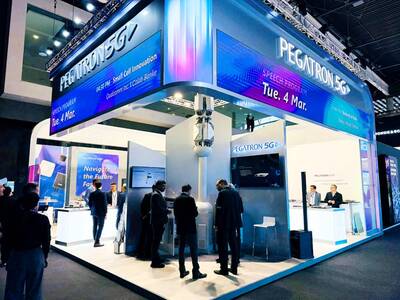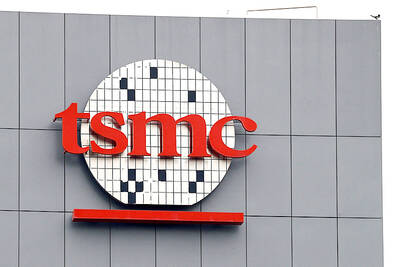Irish no-frills airline Ryanair Holdings PLC rebounded into bumper annual net profits, boosted by a “strong” COVID-19 recovery despite spiking costs, it said yesterday.
Profit after taxation soared to 1.4 billion euros (US$1.5 billion) in the 12 months to the end of March, after a net loss of 355 million euros in its previous financial year, Ryanair said in a statement.
The Dublin-based carrier had narrowed losses in its 2021 to 2022 fiscal year, boosted by the lifting of COVID-19 lockdowns.

Photo: AFP
“Over the last year we have seen a very strong post-COVID traffic recovery,” Ryanair chief executive officer Michael O’Leary said in video remarks published alongside the statement.
“People have been locked up for two years and wanted to go back to traveling,” he added.
Revenue more than doubled to 10.8 billion euros on rising fares, as the group reported “strong market share gains” in Ireland, Italy, Poland, Spain and other European destinations.
Passenger traffic increased 74 percent to 168.6 million travelers, with fares 10 percent higher than pre-COVID levels.
“Traffic is now running at 13 to 14 percent ahead of our pre-COVID volumes, but profitability is still running slightly behind where we were pre-COVID,” O’Leary added.
Profits were lifted by “advantageous” fuel hedges, Ryanair said.
Airlines bet against volatile oil prices by hedging, or taking a defensive position on futures markets.
Total operating costs increased 75 percent to 9.2 billion euros, while the group faced a net loss in the fourth quarter of 154 million euros.
The results come two weeks after Ryanair ordered 300 Boeing Co 737 Max jets worth more than US$40 billion for delivery from 2027, alongside a major recruitment drive to stimulate expansion.
The company is targeting an 80 percent increase in annual passenger traffic to 300 million travelers by 2034, compared with this year.
It plans to recruit more than 10,000 new cabin-crew members, engineers and pilots.
Ryanair’s British rival EasyJet PLC last week reported that it slashed net losses in the first half of its financial year, or six months to March, as the sector recovers.
EasyJet, which posted three annual losses in a row due to the pandemic, predicted a rebound to annual profit as holidaymakers shrug off Britain’s cost-of-living crisis.
“Demand for European summer leisure travel looks robust,” Third Bridge Group Ltd analyst Olly Anibaba said. “Despite inflation weighing on consumer spending, European consumers are still opting for leisure travel over other forms of entertainment.”

STILL HOPEFUL: Delayed payment of NT$5.35 billion from an Indian server client sent its earnings plunging last year, but the firm expects a gradual pickup ahead Asustek Computer Inc (華碩), the world’s No. 5 PC vendor, yesterday reported an 87 percent slump in net profit for last year, dragged by a massive overdue payment from an Indian cloud service provider. The Indian customer has delayed payment totaling NT$5.35 billion (US$162.7 million), Asustek chief financial officer Nick Wu (吳長榮) told an online earnings conference. Asustek shipped servers to India between April and June last year. The customer told Asustek that it is launching multiple fundraising projects and expected to repay the debt in the short term, Wu said. The Indian customer accounted for less than 10 percent to Asustek’s

‘DECENT RESULTS’: The company said it is confident thanks to an improving world economy and uptakes in new wireless and AI technologies, despite US uncertainty Pegatron Corp (和碩) yesterday said it plans to build a new server manufacturing factory in the US this year to address US President Donald Trump’s new tariff policy. That would be the second server production base for Pegatron in addition to the existing facilities in Taoyuan, the iPhone assembler said. Servers are one of the new businesses Pegatron has explored in recent years to develop a more balanced product lineup. “We aim to provide our services from a location in the vicinity of our customers,” Pegatron president and chief executive officer Gary Cheng (鄭光治) told an online earnings conference yesterday. “We

LEAK SOURCE? There would be concern over the possibility of tech leaks if TSMC were to form a joint venture to operate Intel’s factories, an analyst said Taiwan Semiconductor Manufacturing Co (TSMC, 台積電) yesterday stayed mum after a report said that the chipmaker has pitched chip designers Nvidia Corp, Advanced Micro Devices Inc and Broadcom Inc about taking a stake in a joint venture to operate Intel Corp’s factories. Industry sources told the Central News Agency (CNA) that the possibility of TSMC proposing to operate Intel’s wafer fabs is low, as the Taiwanese chipmaker has always focused on its core business. There is also concern over possible technology leaks if TSMC were to form a joint venture to operate Intel’s factories, Concord Securities Co (康和證券) analyst Kerry Huang (黃志祺)

It was late morning and steam was rising from water tanks atop the colorful, but opaque-windowed, “soapland” sex parlors in a historic Tokyo red-light district. Walking through the narrow streets, camera in hand, was Beniko — a former sex worker who is trying to capture the spirit of the area once known as Yoshiwara through photography. “People often talk about this neighborhood having a ‘bad history,’” said Beniko, who goes by her nickname. “But the truth is that through the years people have lived here, made a life here, sometimes struggled to survive. I want to share that reality.” In its mid-17th to